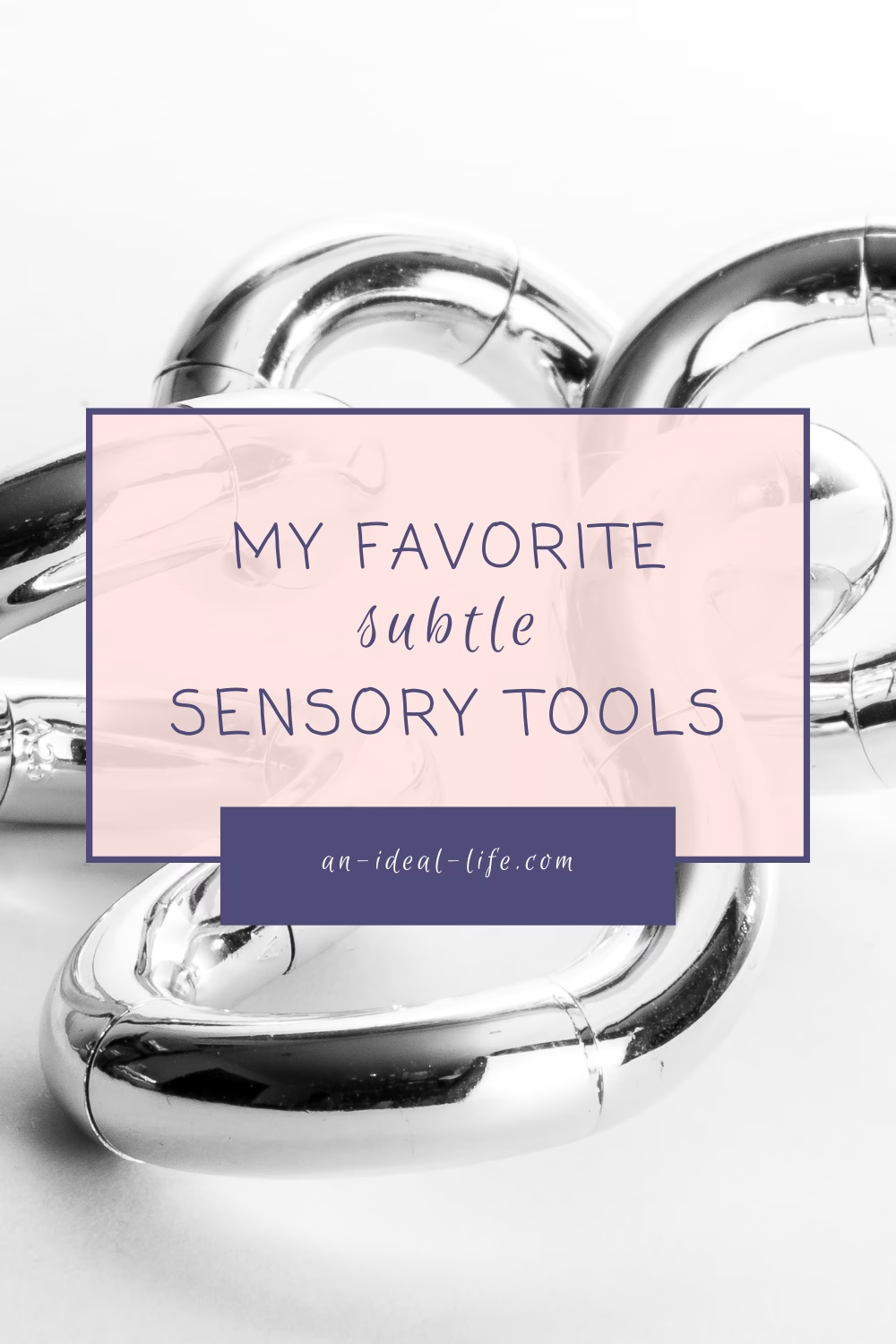
For those of us dealing with ADHD, autism, or general sensory processing issues, fidgets or sensory tools are vital. Depending on your favorite toy or tool though, they’re not always appropriate to bring out in the office or while out and about. That’s where subtle sensory tools come in: toys or fidgets that you can use discreetly.
*This post may include affiliate or referral links. At no extra cost to you (and with a special reader discount, in some cases!), I’ll receive a small commission or other rewards to help support An Ideal Life. As an Amazon Associate, I earn from qualifying purchases*
The information in this blog post is provided for educational and informational purposes only and should not be construed as medical advice. The content is not intended to be a substitute for professional medical advice, diagnosis, or treatment. Always seek the advice of your physician or other qualified healthcare provider with any questions you may have regarding a medical condition. Never disregard professional medical advice or delay seeking it because of something you have read online. The author of this post is not a licensed medical professional and does not assume any liability for any actions taken based on the information contained in this post.
What are sensory tools for ADHD or autism?
Sensory tools are items or actives designed to help people with ADHD, autism, or sensory processing struggles manage sensory input, attention, and emotional regulation. Depending on your needs and the tool you choose, they can calm, stimulate, or organize the sensory system.
What triggers sensory issues?
Sensory issues, sensory sensitivities, or dysregulation happen when the brain has trouble processing and filtering sensory input. Instead of feeling neutral, certain sights, sounds, textures, or other sensations can feel overwhelming, distracting, or even painful.
Sensory triggers vary from person to person, but here’s a breakdown of common types and what might set off sensory distress or overload:
Environmental Triggers
- Loud or unpredictable noises
- Fluorescent or flickering lights
- Strong smells
- Temperature extremes
- Crowded or busy environments
- Uncomfortable textures
Internal & Physiological Triggers
- Fatigue or sleep deprivation
- Hunger or low blood sugar
- Hormonal shifts
- Pain, illness, or chronic fatigue
- Neurochemical factors
Social & Emotional Triggers
- Unexpected social interaction
- Feeling watched or overwhelmed by demands
- Transitions or unpredictability
- High emotional states
Even neutral stimuli can be triggering when they start to pile up! For instance, someone might be okay with only bright lights, background music, hunger, or multitasking…but be pushed into overload when these stack up. This is often why someone seems fine one minute and seems to suddenly melt down, shut down, or withdraw the next. Our brain’s sensory capacity has simply hit its limit!
What does overstimulation feel like?
Overstimulation or sensory overload occurs when there’s too much sensory input—the brain can’t filter, organize, and process it all at once. This might feel like your senses are turned up too high, communication feels impossible, your thoughts race, or you feel irritable, anxious, panicky, or physically trapped.
What does understimulation feel like?
Conversely, sensory deprivation or under stimulation happens when there’s not enough sensory input, leaving the brain craving stimulation to feel awake or engaged. Your brain might feel foggy, you may feel bored or unfocused, or you may feel the need to fidget or even scroll!
Subtle sensory tools like the one below come into play when it comes to sensory regulation. This is about helping your nervous system feel safe and alert.
Finger Spikes
Spikey sensory rings are convenient sensory tools for a bit of tactile stimulation. You can roll the ring up and down your finger for a sort of massage-like sensation—it’s just borderline painful but doesn’t really hurt.
Marble Mesh
Marble mesh fidgets are one of the subtle sensory tools I discovered quite some time after my AuDHD diagnosis but they’re one of my favorites! The little mesh sleeve contains a single marble, with space to move it up and down. The actual motion of moving the marble is so soothing, plus the mesh texture adds a bit of bonus stimuli, too.
Calm Strips
I feel in love with Calm Strips well before I had any idea I was living with ADHD or autism. These little strips are lightly textured (there are actually two different textures available) and make a great grounding tool. I even have a few cheaper off-brand strips that I put in high-use areas like the side of my Stanley tumbler!
Worry Stones
This one’s for my fellow crystal lovelies! Worry stones are just the right size and shape to discreetly hold and rub the indentation. Add a few deep breaths and you have a quick & easy moment of zen.
Bike Chain
I wasn’t sure I’d enjoy bike chain fidget toys when I first received one in a variety pack of sensory tools. Within seconds of trying it, though, they became one of my go-tos. There is a slight noise that comes with flipping it, but it’s pretty discreet.
Hair Tie
In particular, I’d recommend spiral hair ties for this use case! Few people would bat an eye at someone fidgeting with a hair tie on their wrist, and the spirals in particular can act as a more subtle version of the spikey rings from above.
Play Doh
Does anything have as distinct a scent as play doh? This is such a simple but effective fidget, too. Whether you roll a small piece between your figures or build a proper model, the options are pretty much endless. As a bonus, you can get a single jar for about a dollar!
Tangle
I loved Tangles as a kid—one of the many “how did we ever think I was neurotypical?” moments from my childhood. Nowadays, though, they have so many more options! There are classic Tangles, Tangle Pets, metallic Tangles, Tangle Wild, and even textured Tangles. My favorite, though, is the flocked Tangles!
Kneadable Erasers
Some of the most subtle sensory tools out there are those that are technically meant for another purpose, and kneadable erasers are no exception. While they’re technically meant for artists, kneaded erasers are a fantastic fidget tool, sort of similar to play doh or clay in sensation. The classic ones are usually grey but you can find them in all sorts of pretty colors.
Squishmallow Keychain
Squishmallows are great for chronic pain and general sensory comfort, but the Squishmallow clip-on plush are portable and just a little whimsical. A lot like adding a Labubu to your favorite tote, a simple Squishmallow keychain is there to make you smile and give you something to squeeze.
Loop Earplugs
If you’re looking for less sensory stimulation, not more, Loop earplugs—especially Loop Quiet—are an absolute must-have. More discreet than noise-cancelling headphones, these turn down the volume on the noises that are slowly driving you mad (no? just me?).
Essential Oils
I’ve said it before and I’ll say it again—essential oils aren’t going to cure your chronic illness and they certainly won’t make you suddenly neurotypical. But they can offer a little bit of relief! Scents like peppermint or lavender can help provide olfactory stimulation, and a rollerball is easy enough to slip into a purse or pocket.
Warm or Cold Drinks
This might just be the most subtle of these sensory tools! The temperature of a hot drink (think coffee, tea, cocoa) or cold drink (like ice water) can be just enough of a sensory change to soothe or stimulate your nervous system.
What are your must-have discreet sensory tools? Let us know in the comments!






